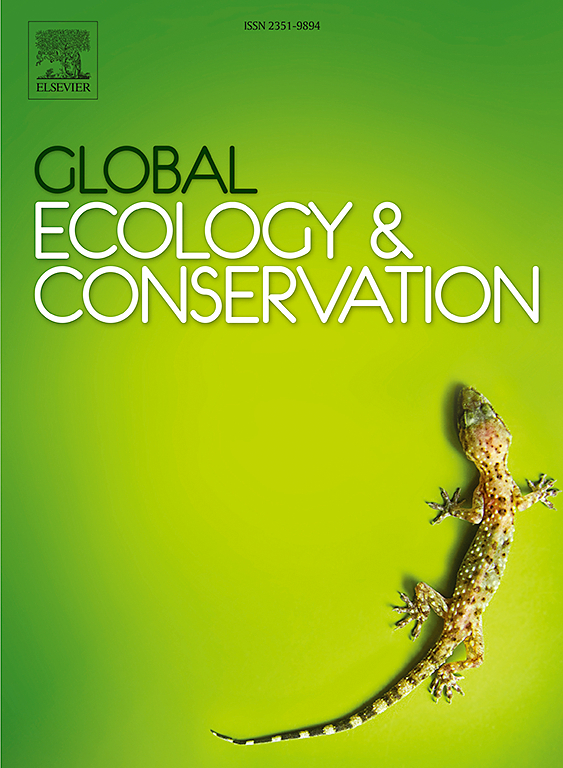土地利用和气候变化对巴西塞拉多地区豆科双翅目昆虫直径的影响
IF 3.5
2区 环境科学与生态学
Q1 BIODIVERSITY CONSERVATION
引用次数: 0
摘要
胸高直径(DBH)与植物的其他属性(如高度、果实数、年龄)有关,因此,它可以指示物种管理和保护的重要特征。在本研究中,我们旨在研究在Cerrado生物群系中,豆科植物alata Vogel (Dipteryx alata Vogel)胸径的空间变化。此外,我们还研究了环境因素和土地利用对白杨胸径变化的影响。在此基础上,通过对其当前和未来的潜在分布进行估算,以评估全球气候变化对其分布的影响。我们使用了一个包含253条DBH记录的数据库,用于分布在塞拉多的D. alata。利用生态位模型确定了每个样本单元的环境适宜性,并对其土地利用类型进行了划分(从牧场到残余植被)。结果表明,天牛的胸径在5 ~ 75 cm之间,没有明显的空间格局。环境适宜性不能预测胸径的空间变化。然而,在土地利用分类为牧场的地区发现了胸径较大的植物。竞争减少、土壤管理和植物年龄(老植物)等因素可能有助于解释牧区DBH较大的原因。值得注意的是,虽然牧区可以作为一些树木的避难所,但适当的管理对于促进个体的补充,确保种群的更新和长期保持多样性至关重要。气候预估预计,在未来的情景中,气候适宜的地区将大量丧失。本文章由计算机程序翻译,如有差异,请以英文原文为准。
The effects of land use and climate change on diameter of Dipteryx alata (Leguminosae) in the Brazilian Cerrado
Diameter at breast height (DBH) is related to various other plant attributes (e.g., height, fruit number, age), and as such, it can indicate important characteristics for species management and conservation. In this study, we aimed to investigate how the DBH of Dipteryx alata Vogel (Leguminosae) varies spatially across the Cerrado biome. Additionally, we examined how environmental factors and land use can influence the variation in DBH of the D. alata. Furthermore, we estimated the current and future potential distribution of D. alata to assess the impact of global climate change on the species' distribution. We utilized a database with 253 records of DBH for D. alata distributed across the Cerrado. For each sample unit, we determined the environmental suitability of D. alata using niche modeling, and land use was characterized and classified into different types (from pasture to remnant vegetation). Our results revealed that the DBH of D. alata ranged from 5 to 75 centimeters, and there was no discernible spatial pattern. Environmental suitability could not predict the spatial variation in DBH. Nonetheless, plants with larger DBH were found in regions classified as pasture in terms of land use. Factors such as reduced competition soil management and age of plants (old plants) may help explain why DBH was greater in pasture areas. It is worth noting that although pasture areas can serve as a refuge for some trees, proper management is essential to promote individuals’ recruitment, ensuring population regeneration and the maintenance of diversity in long time. Climate projections anticipate significant loss of climatically suitable areas for D. alata in future scenarios.
求助全文
通过发布文献求助,成功后即可免费获取论文全文。
去求助
来源期刊

Global Ecology and Conservation
Agricultural and Biological Sciences-Ecology, Evolution, Behavior and Systematics
CiteScore
8.10
自引率
5.00%
发文量
346
审稿时长
83 days
期刊介绍:
Global Ecology and Conservation is a peer-reviewed, open-access journal covering all sub-disciplines of ecological and conservation science: from theory to practice, from molecules to ecosystems, from regional to global. The fields covered include: organismal, population, community, and ecosystem ecology; physiological, evolutionary, and behavioral ecology; and conservation science.
 求助内容:
求助内容: 应助结果提醒方式:
应助结果提醒方式:


